[Editor’s Note: Mad Scientist Laboratory is pleased to publish the first of a three-part series addressing how best to set the Army for the future. Today’s post, by guest blogger Mr. Gary Phillips, addresses Multi-Domain Operations and the cusp — or Crisis — that exists between Competition and Armed Conflict. Focusing on how our Leaders need to set military conditions in Competition while simultaneously maintaining their decisive combat edge to deter Armed Conflict, Mr. Phillips prescribes four things that the Army can do over the next decade to set the Army for the 2030’s. Enjoy!]
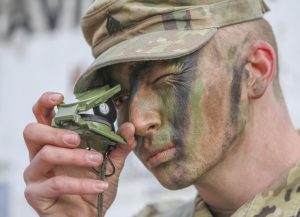
The Army has chosen the concept of Multi-Domain Operations (MDO) to provide an azimuth for the future. Although not common knowledge, concepts are aspirational while doctrine is about how the Army uses what is currently in the force to conduct effective combat operations. This relationship is important as it ideally provides a seamless transition from today’s Army versus today’s enemies to tomorrow’s Army with the capability to fight and win future wars. Much like land navigation, the concept provides an azimuth to an objective and doctrine allows one to deal with the immediate obstacles along that azimuth.
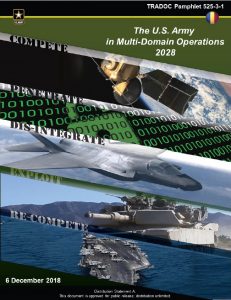 MDO postulates that there are two fundamental time frames or periods. The period of competition and the conflict period. Although this may seem simplistic, it is actually a very elegant way to capture all the activities that nations do in their interactions, from cooperation, to friendly competition, to hostile activities in pursuit of objectives. One additional consideration, not specified in the MDO concept, is the idea of a period between competition and conflict, a transition time that could be labeled “crisis.” Crisis is an odd beast; one might consider it the ultimate hostile competition or the initial stages of conflict. During crisis, the outcome is undecided and the actions by all the participants will define whether the crisis slides back to competition or accelerates into violence inherent in conflict. Setting the Army for the future should be framed by those two periods with special consideration for the transition space between them called crisis.
MDO postulates that there are two fundamental time frames or periods. The period of competition and the conflict period. Although this may seem simplistic, it is actually a very elegant way to capture all the activities that nations do in their interactions, from cooperation, to friendly competition, to hostile activities in pursuit of objectives. One additional consideration, not specified in the MDO concept, is the idea of a period between competition and conflict, a transition time that could be labeled “crisis.” Crisis is an odd beast; one might consider it the ultimate hostile competition or the initial stages of conflict. During crisis, the outcome is undecided and the actions by all the participants will define whether the crisis slides back to competition or accelerates into violence inherent in conflict. Setting the Army for the future should be framed by those two periods with special consideration for the transition space between them called crisis.

The Army’s mission is to “deploy, fight and win the nation’s wars…” 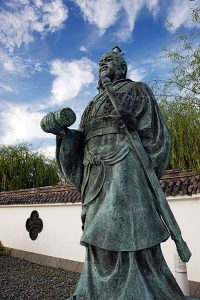 This mission statement captures the idea that the nature of war is coercion — the threat of force or the use of force to set a military condition that allows a favorable political conclusion. What it neglects is the necessity for a different perspective in the competition period described in MDO. Sun Tzu opined that the acme of generalship is winning without fighting. Setting the Army for the future must be built around the idea of an Army fully capable of influence and persuasion during competition, while maintaining the ability to compel and coerce in conflict.
This mission statement captures the idea that the nature of war is coercion — the threat of force or the use of force to set a military condition that allows a favorable political conclusion. What it neglects is the necessity for a different perspective in the competition period described in MDO. Sun Tzu opined that the acme of generalship is winning without fighting. Setting the Army for the future must be built around the idea of an Army fully capable of influence and persuasion during competition, while maintaining the ability to compel and coerce in conflict.
While conflict clearly has the direst consequences in terms of the cost of blood and treasure in accomplishing national objectives, it is actually the more unlikely state of the world. Competition below the level of armed conflict, sometimes just below that level, has become the new norm. Why? 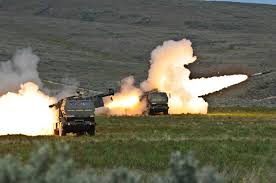 As adversaries and potential adversaries examine U.S. military capabilities, it becomes clear that U.S. forces are extraordinarily capable and competent, making direct confrontation undesirable. What appears as a weakness to our adversaries is U.S. political will and policy. Thus, the choice to pursue national interests by operating under the perceived U.S. policy for the application of military forces seems like a good strategy to nations with interests inimical to the U.S. There are a number of historical data points of U.S. political leadership declaring “red lines” and then doing little when those lines were crossed. The size of the gray area between competition and conflict depends not on stated national policy about undesirable order or disorder in the world, but U.S. actions when confronted with situations contrary to stated policy. When an entity has crossed a policy line and U.S. action is imminent, one enters the crisis period. Forces and authorities not available in competition may be allocated to U.S. Army elements as tools to deter and set the stage to re-enter acceptable competition conditions or to prepare for the crisis moving toward conflict.
As adversaries and potential adversaries examine U.S. military capabilities, it becomes clear that U.S. forces are extraordinarily capable and competent, making direct confrontation undesirable. What appears as a weakness to our adversaries is U.S. political will and policy. Thus, the choice to pursue national interests by operating under the perceived U.S. policy for the application of military forces seems like a good strategy to nations with interests inimical to the U.S. There are a number of historical data points of U.S. political leadership declaring “red lines” and then doing little when those lines were crossed. The size of the gray area between competition and conflict depends not on stated national policy about undesirable order or disorder in the world, but U.S. actions when confronted with situations contrary to stated policy. When an entity has crossed a policy line and U.S. action is imminent, one enters the crisis period. Forces and authorities not available in competition may be allocated to U.S. Army elements as tools to deter and set the stage to re-enter acceptable competition conditions or to prepare for the crisis moving toward conflict.
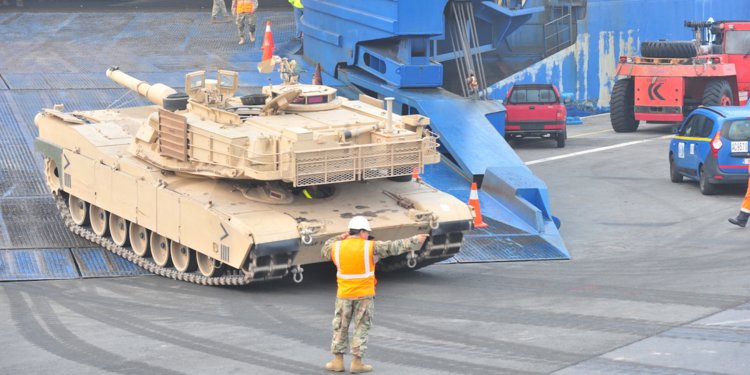
To set the Army for the Future we need to prepare a force that is prepared to set “military conditions” in the competition period while maintaining the edge to continue to make conflict undesirable for current and future adversaries. Just as important is teaching Army leaders how to master new forces and authorities suddenly granted to them during a crisis. The first time an Army leader considers how to apply new means of signaling U.S. disfavor or coercion should not be at the height of tension in a crisis. In most cases, one would imagine that U.S. political leaders would prefer a military de-escalation, vice a miscalculation that begins an irreversible move toward conflict.
One might ask, what does this mean in terms of action? What does the Army need to do to get past admiring the problem and doing something about it to set the Army for the future? There are four things that the Army can do over the next decade to set the Army for the 2030’s.
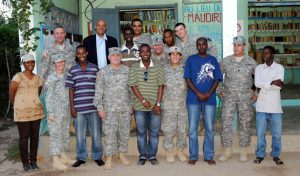
First, prepare our Leaders for an information environment where adversaries will use all of their capability to portray U.S. Army activities in way to diminish prestige and influence. Leaders in this information environment must be savvy on how to shape a narrative that overcomes adversary attempts to paint events in a negative fashion. Action versus reaction must become the norm for information engagement. The Army is the only armed force that directly and repeatedly must interact with foreign populations. As such, the opportunity for positive and negative information engagement is monumental; an opportunity that should not be neglected. This can be especially critical during crises.
 Second, modernize the Army such that the ”Internet of Battle Things” (IOBT) is secure and free from foreign software access points that could corrupt information used by these networked systems. As the U.S. Army increases its reliance on devices that independently share information, harness Artificial Intelligence (AI), and act even semi-autonomously, capability and decision speed increase. However, vulnerability also grows as each node on the network provides a potential attack surface for the adversary. This is especially critical in a coalition environment where the interface between U.S. and allied units may require “middleware” or hardware that is less protected. Commercial off the shelf (COTS) solutions, while cost effective, also increase potential vulnerabilities. China’s advocacy for certain standards for Internet of Things and the proliferation of Chinese produced devices and electronic components in commercial equipment threaten the security of U.S. Army’s IOBT.
Second, modernize the Army such that the ”Internet of Battle Things” (IOBT) is secure and free from foreign software access points that could corrupt information used by these networked systems. As the U.S. Army increases its reliance on devices that independently share information, harness Artificial Intelligence (AI), and act even semi-autonomously, capability and decision speed increase. However, vulnerability also grows as each node on the network provides a potential attack surface for the adversary. This is especially critical in a coalition environment where the interface between U.S. and allied units may require “middleware” or hardware that is less protected. Commercial off the shelf (COTS) solutions, while cost effective, also increase potential vulnerabilities. China’s advocacy for certain standards for Internet of Things and the proliferation of Chinese produced devices and electronic components in commercial equipment threaten the security of U.S. Army’s IOBT.
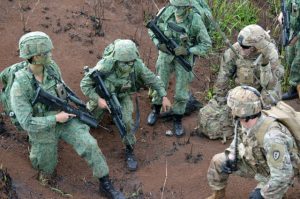
Third, increase U.S. Army engagement and connection to allies and potential allies. Although the Regionally Aligned Forces (RAF) initiative met with mixed success, the idea is sound. U.S. Army leaders and soldiers must build relationships with their allied counterparts. These relationships include a fundamental understanding of the ally’s culture and language. This understanding will be critical to the realization of successful information engagement called for in earlier paragraphs. These connections are invaluable during a crisis, preventing an adversary from exploiting small disconnects and fractures in allied forces and leadership.
 Fourth, recognize that countries will try to move combat “upstream” in the information space to avoid kinetic combat.1 Develop Leaders, build formations, and advance capabilities that give U.S. Army units significance in the competition period beyond simply conducting training events with allies or potential allies. This must include the ability to rapidly shift to conflict with ample capacity to make the decision calculus unfavorable to an enemy.
Fourth, recognize that countries will try to move combat “upstream” in the information space to avoid kinetic combat.1 Develop Leaders, build formations, and advance capabilities that give U.S. Army units significance in the competition period beyond simply conducting training events with allies or potential allies. This must include the ability to rapidly shift to conflict with ample capacity to make the decision calculus unfavorable to an enemy.
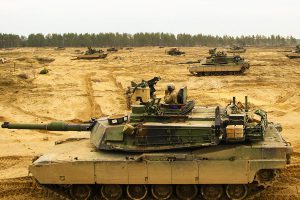
Currently the U.S. Army is gearing up for Large Scale Ground Combat Operations (LSGCO) — and while necessary, this is insufficient to set the Army for the 2030’s. The U.S. Army’s role in the competition period as deterrent, as a friend to our allies, and as a representative of United States cannot be underestimated. Setting the Army for the future is about balancing investments in time and dollars between competition and conflict. Winning a war without fighting is done during competition, and that is what the Army mission needs to include.
For more on the future of Information Operations, see The Death of Authenticity: New Era Information Warfare …
… and with the advent of the IOBT, learn how the U.S. Army must sanitize its information signatures while simultaneously exploit those presented by our potential adversaries in Nowhere to Hide: Information Exploitation and Sanitization.
Mr. Gary E. Phillips was commissioned from the Reserve Officer Training Corps (ROTC) at the University of Southern Mississippi in February 1974 and entered active duty in April 1974. During his tenure in the military, Mr. Phillips served in a myriad of intelligence and operational assignments, ending his Army career as the Commander of the National Ground Intelligence Center in Charlottesville, Virginia.
Since his selection as a Department of the Army Civilian, Mr. Phillips acted as the Director of TRADOC G2 Threats Directorate where he oversaw the development and publication of the Army’s Operational Environment (OE) Estimate in 2000, 2004, 2009 and 2012. In 2006 Mr. Phillips established the Operational Environment Models and Simulations (M&S) Laboratory to insure that the complexities of the OE were represented in Army M&S. This effort has been awarded five Excellence in M&S awards by the Department of the Army and the DOD Award for innovation in gaming. In 2009 Mr. Phillips was selected as a Defense Intelligence Senior Level (DISL) and joined the Senior Executive Service as the Director of the TRADOC G2 Intelligence Support Activity. In 2014 Mr. Phillips became the Senior Intelligence Advisor and Assistant TRADOC G2.
1 Understanding the Information Environment to Win the Next Conflict Without Firing a Shot, Klipstein, Minter, Pittman, 8 March 2019, pg 1. https://nsiteam.com/social/wp-content/uploads/2019/03/ACI-Information-Environment-Final-8Mar19R.pdf




Mr. Phillips, thanks for a most perceptive post that highlights “crisis” in MDO, and highlights the Army’s role in “competition”. There’s a long history of the Army’s utility in OOTW, especially using special operations forces (SF, MISO, CA). There’s also a long history of the use of senior officer engagement, partnership exercises, inviting allied officers to attend US schools, and other mechanisms to both sense the foreign environment to get ahead of crisis, and to build capacity to overcome crisis. One thing is for sure, there will always be competition.